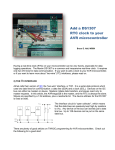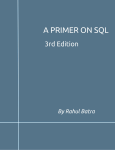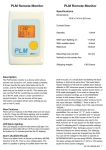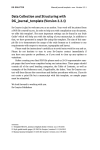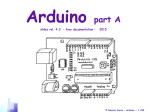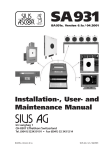Download Accessing C Structs in Assembler
Transcript
www.avrbeginners.net
C/Assembler Tutorial
Accessing C Structs in Assembler
Author: Christoph Redecker
Version: 1.0.2
Accessing C Structs in Assembler
Interrupts
Port I/O
Conditional Branches and Loops
Jumps, Calls and the Stack
Registers and Memories
Introduction to AVRs
This tutorial is licensed under a Creative Commons Attribution–NonCommercial–
NoDerivs 3.0 Unported License:
http://creativecommons.org/licenses/by-nc-nd/3.0/.
Permissions beyond the scope of this license may be available at
http://www.avrbeginners.net.
1
Accessing C structs in assembler programs is not an
AVR issue, but a generic programming problem. However,
knowing how to do it is especially useful when an ISR (or any
other function) must be “hand–coded”. This tutorial outlines
the steps necessary for making C structs and their members’
offsets visible to assembler code and how to use them.
The procedure of making C structs usable in assembler
code is, as it is presented here, neither system– nor compiler–
independent. Nonetheless, it is very easy to port between
systems — I’m not sure about compilers. Furthermore, a text–
processing tool such as gawk is needed. For this tutorial it is
assumed that gcc is used.
gawk
is
available
at
http:
//www.gnu.org/s/gawk/; a win-
dows port is available at http:
Initial Situation
The first thing we need when assembler code must access a C
struct is the C struct itself, including a type definition. These
are in myStruct.h:
#include <stdint.h>
struct SMyStruct_impl
{
uint8_t first;
uint8_t second;
};
typedef struct SMyStruct_impl TMyStruct;
The defined type has two members, first and second, both are
an unsigned 8–bit integer. first starts at offset 0 and second
starts at offset 1. This file is included by our main file, main.c:
#include "myStruct.h"
volatile TMyStruct tMyStruct;
void asm_out(void); /* prototype */
int main(void)
{
tMyStruct.first = 0xAA;
tMyStruct.second = 0x55;
/* here we call the asm function */
asm_out();
while(1);
return 0;
}
//gnuwin32.sourceforge.net/
packages/gawk.htm.
2
Two things must be considered here: the compiler has no control
over the code behind asm_out(). It only knows the prototype of
this function, but not what variables it might touch. This is why
tMyStruct is declared volatile — it prevents the compiler from
optimizing away the two assignments to the struct in main().
asm_out() will later use the values assigned to the struct members. This code is written as if there was no interface between C
and Assembler; in fact, one could know write asm_out() in C.
Extracting the Structure Offsets
The structure offsets are known when TMyStruct is typedef’ed,
so myStruct.h will be needed for this process. Only the compiler can turn the type definition into offsets, so compiler call is
necessary in which the compiler is used to calculate the offsets
and write them into a seperate file. The following is the file
myStruct_offsets.c:
#include <stddef.h>
#include "myStruct.h"
#define _ASMDEFINE(sym, val) asm volatile \
("\n-> " #sym " %0 \n" : : "i" (val))
#define ASMDEFINE(s, m) \
_ASMDEFINE(offsetof_##s##_##m, offsetof(s, m));
These macros, as well as the
following
procedures,
are
based
on
those
presented
at
http://docs.blackfin.uclinux.org/
doku.php?id=toolchain:gas:structs
myStruct_defineOffsets() {
ASMDEFINE(TMyStruct, first);
ASMDEFINE(TMyStruct, second);
}
Two macros are defined: _ASMDEFINE(sym, val) and ASMDEFINE(s, m).
ASMDEFINE uses s (a structure name) and m (a structure member) to assemble a symbol string. Assuming that s is TMyStruct
and m is first, the string is offsetof_TMyStruct_first.
Then _ASMDEFINE is used to insert a line of assembler into
the compiler output, using asm volatile. This is a “fantasy”
instruction, starting with ->. Afterwards val is added as an
integer value at the end of the line. val was supplied by the
calling macro, ASMDEFINE, and is equal the the member’s offset
in the struct.
At the end of myStruct_offsets.c, the two offsets are actually created, by calling ASMDEFINE in a function. This is a
dummy function and will not show up in the final binary!
The assembler, which is gas in this case, cannot assemble the
lines starting with -> — it would emit an error, because -> is
not a valid assembler instruction. The compiler needs to be
3
stopped before it calls the assembler. For gcc, this is done with
the -S option. If you haven’t done this before, create the files
myStruct.h and myStruct_offsets.c, each with the content
shown above, open a terminal and execute
avr-gcc -S myStruct_offsets.c -o -
The trailing - is important, as it tells the -o option to write
the output to stdout. You should see the object file output,
including two lines starting with ->. Here is a sample:
myStruct_defineOffsets:
push r29
push r28
rcall .
in r28,__SP_L__
in r29,__SP_H__
/* prologue: function */
/* frame size = 2 */
/* #APP */
; 53 "myStruct_offsets.c" 1
-> offsetof_TMyStruct_first 0
As you can see, the function myStruct_defineOffsets is created, and at the end of the above piece of object code the offset
of the first member of TMyStruct is shown — we’re almost
there. The -> lines now have to be extracted from the object
code, which can be done using gawk:
avr-gcc -S myStruct_offsets.c -o - | gawk ’($1 == "->")
{ print "#define " $2 " " $3 }’ > myStruct_offsets.h
The compiler output is piped to gawk, which replaces -> with
#define, and writes the resulting line to its own output. gawk’s
output is written to myStruct_offsets.h. That file now contains:
#define offsetof_TMyStruct_first 0
#define offsetof_TMyStruct_second 1
Using the Structure Offsets
Now it’s time to include this header file in an asm file called
asm_out.S:
#include <avr/io.h>
#include "myStruct_offsets.h"
#define work 18 // our working register
4
.extern tMyStruct ; "import" tMyStruct from main.c
.section .text
.global asm_out ; "export" for the linker
asm_out:
; directly accessing the first struct member, as in
; PORTD = tMyStruct.first;
lds work, tMyStruct + offsetof_TMyStruct_first
out _SFR_IO_ADDR(PORTD), work
; directly accessing the second member
lds work, tMyStruct + offsetof_TMyStruct_second
out _SFR_IO_ADDR(PORTD), work
; indirect access: Z->tMyStruct as in
; TMyStruct* Z = &tMyStruct;
ldi ZL, lo8(tMyStruct)
ldi ZH, hi8(tMyStruct)
; indirectly accessing the first member as in
; PORTD = Z->first;
ldd work, Z+offsetof_TMyStruct_first
out _SFR_IO_ADDR(PORTD), work
; indirectly accessing the second member
ldd work, Z+offsetof_TMyStruct_second
out _SFR_IO_ADDR(PORTD), work
ret
The assembler file includes the headers, imports the symbol
tMyStruct and places asm_out in the text section.
asm_out writes the values of each structure member to PORTD
in two different ways (you should be familiar with them). It
is “exported” as a global symbol so that the linker can find it.
Finally, it is possible to call the asm function from C (main.c):
#include "myStruct.h"
volatile TMyStruct tMyStruct;
void asm_out(void); /* prototype! */
int main(void)
{
tMyStruct.first = 0xAA;
tMyStruct.second = 0x55;
asm_out();
More
about
sections
http://www.nongnu.org/avr-libc/
user-manual/mem_sections.html
at
5
while(1);
return 0;
}
One final note: the structure must be declared volatile, because
the compiler could otherwise optimize the member assignments
away – they are not used in any part of code that the compiler is
aware of.
Putting it all Together
After everything is more or less explained, we can put the whole
thing together:
First, create a C file for each structure you need the offsets of.
The macros defined above can be put into a header file, call it
asmDefine.h for example. The newly created C files need to be
compiled every time the structure definition changes, using the
command line that first creates object code and then extracts the
offsets. This can be done with an IDE that support pre–build
steps, a batch file, or built into a makefile — your choice.
Second, include the generated header file in any assembler
file that needs access to the offsets. Any structure that is used
must be imported as an external symbol for the linker to find it.
Third, take into account that the compiler is not aware of
the assembler code’s functionality. Depending on optimisation
settings, it might delete assignments in your main code if they
are of no effect to the compiler.








